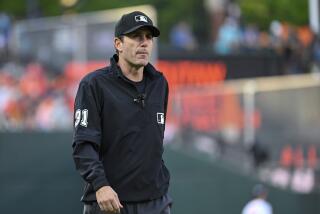Play Might Lead to One Change
- Share via
Two baseball regulations whose origins date to the mid-19th century, both relating to a swinging third strike and the actions of the three men closest to it, appear to have had a significant influence on the 2005 American League championship series, and could alter umpiring procedures.
The controversial ninth-inning events that led to the Chicago White Sox’s victory over the Angels on Wednesday night brought a day of review by Major League Baseball officials, who Thursday night supported plate umpire Doug Eddings’ decisions and the manner in which he expressed them.
“I think Doug should sleep fine,” said former umpire Steve Palermo, now a supervisor of major league umpires. “I hope people realize that if we are able to clarify this, Doug Eddings did everything he was compelled to do and required to do. And he did all of those things consistently. He did his job.
“He is in this position because he earned it. I think a lot of people are shooting the messenger here. He didn’t make the rule, he’s enforcing it.”
Eddings, who will umpire the right-field line in tonight’s Game 3, incurred the ire of the Angels when, with the score tied and two out in the bottom of the ninth, he ruled that Angel catcher Josh Paul had trapped a pitch by Kelvim Escobar that White Sox batter A.J. Pierzynski swung over for strike three.
Apparently believing that Eddings had raised a fist to signal Pierzynski out, Paul rolled the ball to the pitcher’s mound, and his teammates followed him from the field. Pierzynski dashed to first, was declared safe on a technicality, and a pinch-runner scored from second base three pitches later. The score was no longer tied, but the series was, at one game apiece.
Eddings, by the rules of baseball, had determined that Paul had not “legally caught” the pitch, and therefore would have to tag Pierzynski or throw to first base for the out.
Angel Manager Mike Scioscia argued that whether Paul caught the ball on the fly or a bounce, Eddings had indicated Pierzynski was out, with a sweep of his hand and a clenched fist, leading the Angels to believe the inning was over.
After reviewing tapes of the game, Mike Port, baseball’s vice president/umpiring, said he could not determine whether the ball was “legally caught” but was satisfied Eddings’ gestures were consistent with those made in earlier strike three situations.
“Procedurally, it was handled the right way,” said Port, the former Angel general manager. “Summarily, Doug Eddings did nothing wrong. He gave the same signal for all swinging strikes. If the question is, ‘Did he call Pierzynski out on strikes?’ The answer is no. He was indicating the batter swung at the pitch.”
The term “legally caught” appeared when a Branch Rickey-led committee recodified the rule book for the 1950 season.
As written then, Rule 6.05 (b) states, “A batter is out when a third strike is legally caught by the catcher,” disallowing a ball that bounces, is trapped or becomes lodged in the catcher’s gear or uniform.
Jim Gates, head librarian at the National Baseball Hall of Fame, said the rule’s origin dates to at least 1858, though at that time catchers were positioned 25 feet behind the batter and wore no protective equipment, and therefore a legal catch could be made after one bounce. “For consistency’s sake,” Palermo said, “baseball is resistant to change what it does.... We’re starting to tinker with some of the dynamics of the game.”
The 19th-century principles that led to Rule 6.09 (b), which fundamentally declares that a batter becomes a runner when the third strike is not caught, did not so much allow a batter to reach base as require him to attempt it. Until 1883, according to Gates, no rule existed that obligated a batter to leave the batter’s box.
Hitters now routinely run from the batter’s box on low strike three misses, and catchers routinely tag them or throw to first, even when they are reasonably sure the ball did not touch the ground.
Port said baseball would consider asking or requiring umpires to call the play aloud. That is, to notify the catcher and hitter, “No catch” or “It’s in play,” in similar circumstances. Those words Wednesday night probably would have ended the ninth inning.
“We talk about the games being left in the hands of the players,” Port said. “Now, you’ve got that situation. Is it not [Paul’s] responsibility to make sure the runner is out?
“We have to be open to considering such things [as verbal alerts]. I will rely on the advice of the supervisors.”
Said Palermo, “You have to put some accountability on the players, as far as field awareness.”
The league historically has resisted the use of instant replay, which is used to varying degrees in the NFL, NBA and NHL, and Wednesday night’s play will not be the impetus for inclusion. Previously, Commissioner Bud Selig was said to be considering using replay to monitor small parts of the game, such as confirming whether game-ending home runs were hit fair, but not seriously.
The umpires probably would be opposed to the practice, which could only be adopted through collective bargaining between baseball and the umpires’ union.
In the meantime, the effect of Pierzynski’s swing, and Paul’s mitt, and Eddings’ decision will be confined to this series, and perhaps the next.
“That play,” White Sox first baseman Paul Konerko said, “we’re not going to see that again maybe for as long as we live.”
More to Read
Go beyond the scoreboard
Get the latest on L.A.'s teams in the daily Sports Report newsletter.
You may occasionally receive promotional content from the Los Angeles Times.






